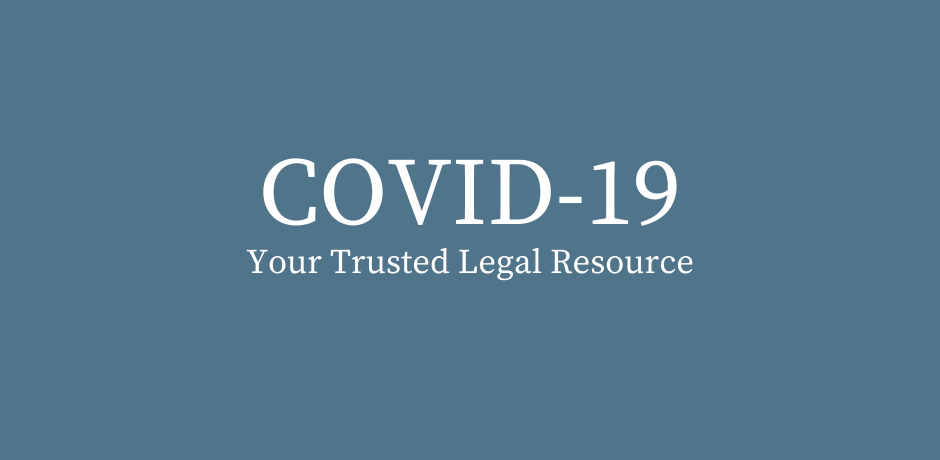What employers need to know: Families First Coronavirus Response Act

Author: Kevin S. Smith
POST DATE: 3.19.20

On Thursday, March 19th President Trump signed into law “The Families First Coronavirus Response Act” (“FFCRA”). Below is information concerning the FFCRA and what it will mean for employers.
Key Changes to FMLA by the FFCRA
First, the FFCRA expands the FMLA to specifically cover incidents where a worker is absent, and cannot telework, due to a need for leave to care for a son or daughter under 18 years of age if the child’s school or place of child care is closed due to a public health emergency. In such an instance, the FMLA’s coverage is expanded with regard to who is considered an “eligible employee” and who is considered a “covered employer.” A “covered employer” (for the occurrence listed above) is any employer who has fewer than 500 employees (whereas normally the FMLA generally covers employers with 50 or more employees), and an “eligible employee” (for the occurrence listed above) is anyone who has worked for a covered employer for 30 days or more (instead of being someone who has worked for a least a year and at least 1250 hours in the preceding 12 months).
Second, the FFCRA requires that eligible employees off work for the reason stated above must be provided paid leave by their employers if the leave extends more than 10 days. (The first 10 days are unpaid, but the employee can elect to use accrued PTO, vacation, sick days, etc. in accordance with the employer’s normal policies (if the employer has them).) For the remaining 10 weeks of job-protected leave that the employee is off, the employee must be paid at least two-thirds of the employee’s regular rate of pay, up to a maximum of $200 per day and $10,000 in the aggregate. Before now, the FMLA never required an employer to provide paid leave to an employee above and beyond whatever paid time off (if any) that it already provided. To help combat this financial burden on employers, employers will receive a tax credit on the employer’s portion of the Social Security payroll tax on a quarterly basis for paid FMLA leave paid to employees (not to exceed $10,000 per employee).
Third, employers with fewer than 25 employees need not restore an employee who takes the leave described above to his/her former position if: (a) the position no longer exists “due to economic conditions or other changes in operating conditions of the employer … that affect employment … and are caused by a public health emergency during the period of leave”; and (b)”[t]he employer makes reasonable efforts to restore the employee to a position equivalent position. If those reasonable efforts fail, then the employer, for the next year, must make reasonable efforts to contact the employee if an equivalent position subsequently becomes available.
Emergency Paid Sick Leave
The FFCRA also contains a separate provision (called “Emergency Paid Sick Leave”) requiring all public employers, and private employers with fewer than 500 employees, to provide up to 80 hours of paid sick leave to any employee who:
- is subject to a Federal, State, or local quarantine or isolation order related to COVID-19;
- has been advised by a health care provider to self-quarantine due to concerns related to COVIC-19;
- is experiencing symptoms of COVID-19 and is seeking a medical diagnosis;
- is caring for an individual who is subject to a items (1) or (2) above;
- is caring for his/her son or daughter because the child’s school or place of childcare has closed to COVID-19; or
- “[t]he employee is experiencing any other substantially similar condition specified by the Secretary of Health and Human Services in consultation with the Secretary of the Treasury and Secretary of Labor.”
The amount of the Emergency Paid Sick Leave is: (a) the employee’s full regular rate of pay (up to a maximum of $511 per day ($5,100 in the aggregate)) if s/he is cannot work or telework because of items (1)-(3) listed above; and (b) two-thirds of the employee’s full regular rate of pay (up to a maximum of $200 per day or $2,000 in the aggregate) if s/he cannot work or telework because of items (4) - (6) listed above.
The Act allows employers to claim, for each quarter of the 2020 tax year, a tax credit equal to 100% of Emergency Sick Leave paid during each quarter (to a maximum of 10 days for each employee who receives Emergency Sick Leave), which can be applied to the total taxes imposed on the employer portion of the Social Security payroll tax. However, the amount of the credit is capped at $511 per day per employee who is off work for items (1) – (3) listed above, and capped at $200 per day per employee who is off work for items (4) – (6) listed above.
The Emergency Paid Sick Leave required by the FFCRA is in addition to whatever sick leave or PTO an employer currently provides. The Act prohibits an employer from: (a) altering pre-existing sick leave or PTO policies to avoid or minimize the impact that the FFCRA’s Emergency Paid Sick Leave requirement will have on the employer; and (b) forcing employees to use up existing sick leave or PTO before utilizing the Emergency Paid Sick Leave required by the FFCRA.
Exemptions/Exceptions
The Act requires the Department of Labor to draft regulations providing a way for employers with 50 or fewer employees, whose viability may be threatened by the Emergency Paid Sick Leave requirements, to seek exemption from them. We do not know at this time what the exemption requirements will be.
Conclusion
The FFCRA goes into effect 15 days from today (April 2, 2020). That means that employers should, right now, start considering how they will handle and pay for requests for time off that fall under the new FMLA provisions and the new Emergency Paid Sick Leave provisions of the FFCRA.
Employers in industries hit hardest by the coronavirus pandemic may be considering shutting down entirely or laying off most workers but a skeleton crew to save money. Of course, employees who are discharged from employment are no longer entitled to FMLA leave and/or paid sick leave from their former employer. However, the FFCRA is very clear that employers cannot discharge employees for taking the leave granted to them under the FFCRA (or being perceived likely to do so). Employers that lay off their entire workforces are not in much risk of being perceived as having fired a particular employee because s/he might exercise rights to leave under the FFCRA. But employers who layoff only a portion of their workforce must have legitimate, non-leave-related, well-documented reasons for selecting which employees will be terminated and which will not.
CCHA is committed to helping you navigate this new law. Contact our employment law attorneys to discuss your immediate needs — we’re your advocates and so much more.

